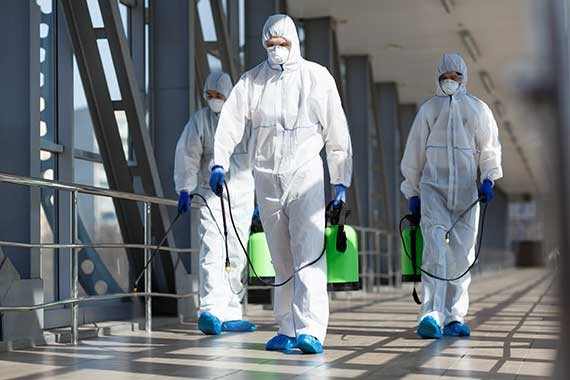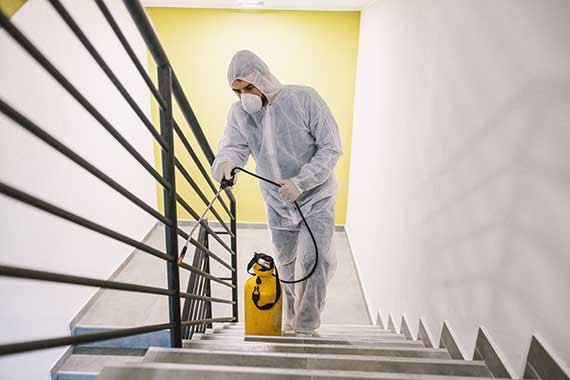Our Services
COVID-19 Cleaning & Disinfection
COVID-19 is an extremely serious situation and we understand that the health and safety of you, your family, and employees are on the line. Don't take any chances; call in the professionals.
Why Get a COVID-19 Deep Clean?

With the global spread of the Coronavirus, everybody has started to become more vigilant about the need to disinfect as well as carry out deep cleaning.
Sadly the virus spreads easily and is evident from the millions of infected people in many countries worldwide, as well as the resulting death toll.
Our professional coronavirus deep cleaning service is the comprehensive available. We understand the importance of sanitising properly all surfaces, touch points, floors, any equipment and furniture.
Needless to say this is a rigorous process that calls for expertise, proper tools, and a commitment to be as thorough as possible. The sanitisation process also includes a full fogging service.
Protect Your Office or Home

Proper disinfection is critical to safeguard yourself and your loved ones. This applies to both households as well as workplaces and offices.
It is critical to sanitise tables, desks, fixtures, doors, and frames. We also place importance on the need to sanitise office equipment and any appliances such as keyboards, mice, fridges and machinery. The floors will be thoroughly cleaned, . just with normal mopping and washing but with proper sanitisation. This includes ledges, and skirtings.
In the case of business premises, we will . only clean the offices but we will also see to the sanitisation and deep cleaning of common areas such as lifts, stairwells, staff kitchens, reception areas, meeting and board rooms, corridors and lobbies.
CDC Recommended Cleaning and Disinfection Procedures for COVID-19
The Truth Behind Fogging:
It must always be a 2 step process, sanitizing ( in essence cleaning ) and disinfecting. As we are facing the new normal, government organizations like the CDC have come together to give us real-time updates and best practices to continue to be safe. This includes guides focused on cleaning versus disinfecting, targeted to teach people how to best disinfect coronavirus and other common household germs, including cold and flu viruses. The surface be cleaned with a sanitizer. Once dry, the surface should then be sprayed with a disinfectant.
Simply 'Fogging' Could be a Violation of Health and Safety Laws
Simply 'Fogging' an area with a disinfectant doesn't meet EPA-registered label requirements without proper pre-cleaning and may be a violation of health and safety. More importantly, improper application of the disinfectant can lead to a false sense of security, an increase in health hazards and . be effective at reducing the risk of the spread of COVID-19.
Many companies are taking the cheapest route with just simple fogging and whilst one can understand the business logic, the reality is far different and more costly in that the COVID 19 virus is . inactivated ( " killed " ) but remains surviving for up to 3 to 7 days on hard surfaces and when your team returns they will be infected again.
Imagine the true financial cost and implication, if you had a Team A and one of the team was tested positive with the Covid 19 virus and you brought in team B and they touched one of contact points where Team A was, they would be infected again. Think for one moment what the implications would be and the reality your business may . be able to recover as both teams would need to self isolate for 14 days.
Lastly can one put a price on a human life or worse the shortcut cost the business its existence. Don't take short cuts .
The CDC recommends using EPA-registered disinfectants with an emerging virus claim, according to label directions, and following a cleaning of the surface. No disinfectant will be effective unless the surface is first cleaned ( sanitized ). Every EPA-registered disinfectant also requires a specific length of contact time in which the surface must remain wet with the disinfectant, prior to air drying or mechanical rinsing/drying.
Our Services incorporate the following:
- * Coronavirus (Covid-19) Prevention Deep Cleaning
- * Viral Infection Management
- * Covid-19 Cleaning Advice
- * Infection Prevention Control Cleaning
- * Covid-19 Cleaning Contractors
- * Coronavirus Prevention Cleaning
- * Medical Facility Deep Cleaning Specialists
- * Anti Virus Deep Cleaning Specialists
- * Infection Prevention Coronavirus Hygiene Advice
Do I need to 'Deep Clean' for Coronavirus?
The Center for Disease Control and the World Health Organization have both signaled the importance of having a clean, sanitized, and disinfected environment to help control the spread of the coronavirus (COVID-19). The CDC specifically recommends "the cleaning and disinfection of homes and facilities." Undertaking these 3 steps is more commonly known as performing a 'deep clean'. We want to assist in heeding the calls of these health organizations by helping you understand what it means to perform a 'deep clean'. The health and safety of you and your family is our top priority and understanding how to fight against the spread of the illness is critical.
What is the difference: Cleaning, Sanitizing, and Disinfecting
Most important to understand is that cleaning does . kill bacteria, viruses, or fungi more commonly referred to as "germs". Instead cleaning is done to remove "germs" usually by combining water, a cleaning product, and scrubbing. Though cleaning does . kill 'germs' it is still a vital step in the deep cleaning process as removal of dirt and debris can make way for products and methods that do kill 'germs' to be more efficacious. Disinfecting and sanitizing methods on the other hand refer to products that work by killing germs. These processes do not necessarily clean dirty surfaces or remove germs, but by killing germs on a surface after cleaning, it can further lower the risk of spreading infection. Sanitizers reduce bacteria on a surface by at least 99.9%. Conversely disinfectants kill a wider range of microorganisms including bacteria, viruses, fungi, and mold. These methods work great on all surfaces like natural stone including marble, granite, and limestone, upholstery, fabrics, and drapes; and carpets and area rugs on hard non-porous surfaces like stainless steel and the components of your HVAC system.
How do you Sanitize and Disinfect during a Deep Clean?
Our 'deep clean' method utilizes three techniques depending on the need.
- 1. Wet sprays - Using wet sprays allows our technicians to completely coat a surface in the sanitizing or disinfecting solution. After the solution is applied wet it is allowed to dry to ensure effectiveness.
- 2. Surface wiping - Wiping allows our technicians to target specific areas to ensure targeted germ killing. The solution is applied wet, allowed to dwell for 10 minutes, then wiped for maximum effectiveness.
- 3. Fogging - Fogging allows our technicians to deliver sanitation and disinfecting solution to hard to reach places and nooks and crannies otherwise missed.
